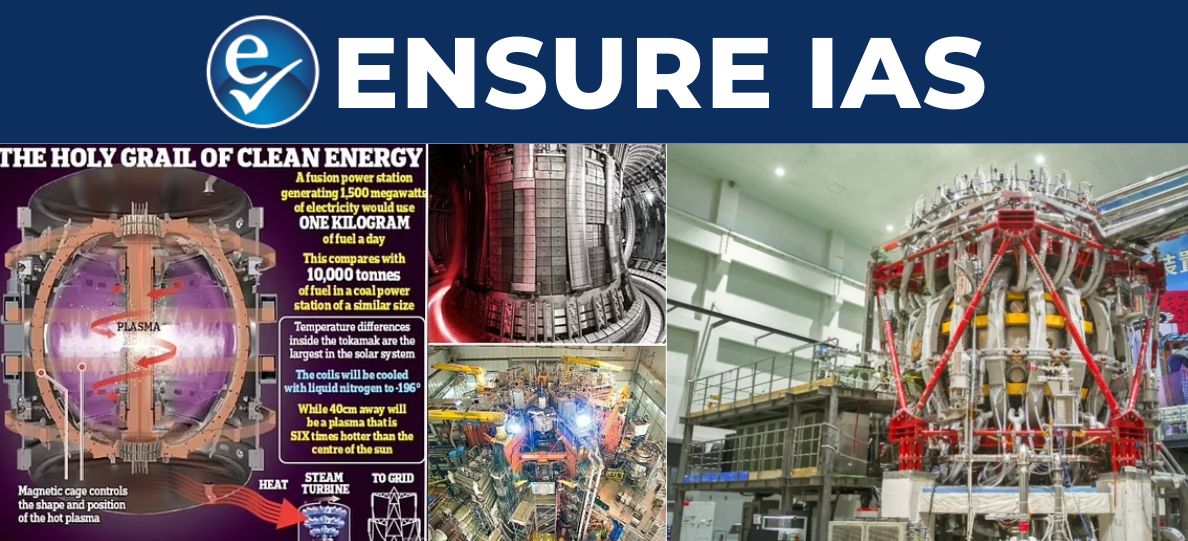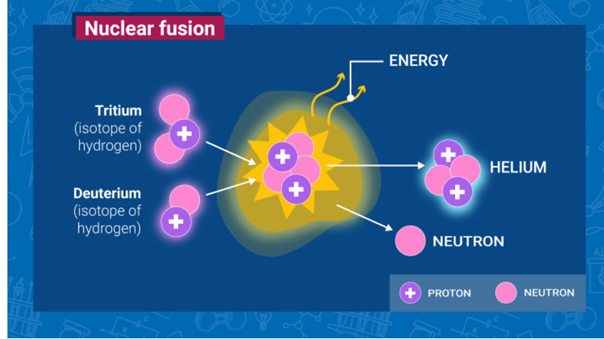- Courses
- GS Full Course 1 Year
- GS Full Course 2 Year
- GS Full Course 3 Year
- GS Full Course Till Selection
- Answer Alpha: Mains 2025 Mentorship
- MEP (Mains Enrichment Programme) Data, Facts
- Essay Target – 150+ Marks
- Online Program
- GS Recorded Course
- Polity
- Geography
- Economy
- Ancient, Medieval and Art & Culture AMAC
- Modern India, Post Independence & World History
- Environment
- Governance
- Science & Technology
- International Relations and Internal Security
- Disaster Management
- Ethics
- NCERT Current Affairs
- Indian Society and Social Issue
- NCERT- Science and Technology
- NCERT - Geography
- NCERT - Ancient History
- NCERT- World History
- NCERT Modern History
- CSAT
- 5 LAYERED ARJUNA Mentorship
- Public Administration Optional
- ABOUT US
- OUR TOPPERS
- TEST SERIES
- FREE STUDY MATERIAL
- VIDEOS
- CONTACT US
China advances in Nuclear Fusion with EAST Reactor
China advances in Nuclear Fusion with EAST Reactor

Recent Context
- The Experimental Advanced Superconducting Tokamak (EAST) is an experimental nuclear fusion reactor in Hefei, east China's Anhui Province.
- It has set a new world record by sustaining plasma for 1,066 seconds, or over 17 minutes in January 2025.
- This surpasses the previous record of 403 seconds which was also set by EAST in 2023, marking a significant leap in nuclear fusion research
- The reactor is dubbed China's "artificial sun," because it generates energy through nuclear fusion process similar to that of the sun.
What is the Experimental Advanced Superconducting Tokamak project?
- The national project of experimental advanced superconducting tokamak (EAST) is the important part of the nuclear fusion development strategy of China.

What is a Tokamak?
|
- Aim: To replicate the process of nuclear fusion, which is the same reaction that powers the sun.
- It was approved by the Chinese government in 1989 and began operations in 2006.
- EAST is the first fully superconducting tokamak in the world.
- Superconductors are materials where electrical resistance vanishes, and magnetic fields are expelled from the material. This allows electric current to flow indefinitely without any energy loss.
- Examples include Lead, Mercury, Niobium-Titanium alloys etc.
-
How does EAST work?
- Plasma Generation
- Hydrogen isotopes (like deuterium and tritium) are heated, creating plasma.
- Plasma is hot, charged gas made of positive ions and free-moving electrons with unique properties distinct from solids, liquids, or gases.
- Magnetic Confinement
- Superconducting magnets generate a strong magnetic field and stabilizes the plasma in a toroidal (doughnut-shaped) configuration.
- The magnets prevent the plasma from touching the reactor walls and cooling down.
- Sustained Fusion Conditions
- EAST aims to sustain plasma temperatures of over 100 million degrees Celsius, hotter than the Sun’s core.
- When the plasma reaches the necessary temperature and density, deuterium and tritium (forms of hydrogen) nuclei fuse together, releasing a significant amount of energy.
- Plasma Generation
- EAST is also a part of the International Thermonuclear Experimental Reactor (ITER) program after China joined the initiative in 2003. It acts as a testbed for ITER technologies.
What is the International Thermonuclear Experimental Reactor (ITER)?
- ITER is the world’s largest tokamak coming up in southern France with the collaboration of 35 countries including India.
- Goal: To achieve fusion power production at power plant scale, breaking new ground in fusion science and demonstrating fusion reactor technology.
- Members: China, the European Union, India, Japan, Russia, South Korea and the United States
-
Background
- ITER was set in motion at the Geneva Superpower Summit in November 1985, proposed by General Secretary Gorbachev of the former Soviet Union to US President Ronald Reagan.
- In 1986, an agreement was reached between the European Union (Euratom), Japan, the Soviet Union and the USA for jointly designing ITER.
- The People's Republic of China and the Republic of Korea joined the project in 2003, followed by India in 2005.
- ITER Agreement: It was signed in November 2006 by the 7 ITER members
- The contributions for construction by the members are as follows:
- Europe is responsible for the largest portion of construction costs (45.6 percent)
- The remainder is shared equally by China, India, Japan, South Korea, Russia and the United States (9.1 percent each)
- India has supplied Cryolines for the ITER project.
- Cryolines are networks of pipes that transport cryogenic liquids, such as liquid nitrogen and helium, to superconducting magnets.
-
What will ITER do?
- Achieve a deuterium-tritium plasma in which the fusion conditions are sustained mostly by internal fusion heating
- Generate 500 MW of fusion power in its plasma for long pulses
- Contribute to the demonstration of the integrated operation of technologies for a fusion power plant.
- Test tritium breeding
- Demonstrate the safety characteristics of a fusion device
-
What is its status?
- As of April 2022, ITER is nearly 85% complete toward first plasma.
- The first plasma was scheduled for late 2025, but it has been delayed.
- As per the new schedule:
- Full plasma current in 2034
- The start of operations with a deuterium-deuterium plasma in 2035,
- Deuterium-tritium operations in 2039.
What is Nuclear Fusion?
- Nuclear fusion is the process by which two light atomic nuclei (for example Tritium and Deuterium) combine to form a single heavier (Helium) one while releasing massive amounts of energy.

- The energy from the Sun - both heat and light energy - originates from a nuclear fusion process that is occurring inside the core of the Sun.
- Fusion reactions take place in a state of matter called plasma, a hot, charged gas made of positive ions and free-moving electrons with unique properties distinct from solids, liquids, or gases.
-
What are the conditions to achieve fusion?
- Temperature of more than 100 million degree Celsius
- Maintaining a high enough density for a long enough time so that the rate of fusion reactions will be large enough to generate the desired power.
What are the differences between Nuclear Fusion and Nuclear Fission?
|
Aspect |
Nuclear Fusion |
Nuclear Fission |
|
Process |
Combining light nuclei to form a heavier nucleus |
Splitting a heavy nucleus into lighter nuclei |
|
Energy Output |
Produces significantly more energy |
Produces less energy compared to fusion |
|
Fuel |
Uses isotopes of hydrogen (deuterium and tritium) |
Uses heavy elements like uranium-235 or plutonium-239 |
|
Byproducts |
Helium, which is non-toxic |
Radioactive waste that requires long-term storage such as Cesium-137, Strontium-90, Krypton etc. |
|
Safety |
Inherent safety due to high temperature and pressure requirements and reactions stop if requirements are not met. |
Risk of runaway reactions or meltdowns (e.g., Chernobyl, Fukushima) |
|
Proliferation Risk |
Low, as fusion fuel is not easily weaponized |
High, as fission fuel can be used in nuclear weapons |
|
Current Use |
Primarily experimental; not yet used for commercial power generation |
Widely used in nuclear power plants |
What are the advantages of Nuclear Fusion?
- Production of abundant energy: The fusion process produces far greater amounts of energy than any other source — one gram of fuel can yield as much energy as burning about eight tons of coal.
- Widely available fuels: The input materials used are available in almost limitless supply (deuterium and tritium, two heavier isotopes of hydrogen that are used as fuel, are easily available in nature).
- Zero emission footprint: The production of energy through nuclear fusion does not emit greenhouse gases like CO2.
- Minimal Radioactive Waste: The byproducts (mainly helium) are non-toxic and do not pose long-term storage challenges like nuclear fission waste.
- Inherent Safety: Fusion reactions require extreme conditions (high temperature and pressure) and reaction stops if these conditions are not met. Thus, there is no risk of runaway reactions or meltdowns like in fission reactors (e.g., Chernobyl, Fukushima).
- Less Risk of Nuclear Proliferation: Fusion fuel (deuterium and tritium) is not easily weaponized, unlike uranium or plutonium used in fission reactors.
What are the challenges in achieving Nuclear Fusion?
- Extreme Conditions needed: Fusion reactions require very high temperatures, hundreds of millions of degrees Celsius — higher than the temperatures in the Sun’s core.
- Plasma Confinement Issues: It is difficult to contain or stabilize plasma. Plasma instability (turbulence, disruptions) can shut down the reaction.
- High Energy Input compared to Output: Current experimental reactors consume more energy than they produce. For fusion to be viable there needs to be net energy gain, where fusion produces more energy than required to sustain the reaction.
-
Development issues:
- High cost of development: Such as for developing materials that can withstand prolonged exposure to the extreme temperatures and radiation within fusion reactors.
- Long Development Timeline: Even as per optimistic forecasts producing electricity at a commercial scale using nuclear fusion would not be realised before 2050.
What are other initiatives towards Nuclear Fusion?
- Fusion Device Information System (FusDIS) database (by IAEA): A total of 163 fusion reactors, in about 30 countries, are currently in operation, under construction, or being planned.
- United Kingdom-based JET laboratory produced about 12 MW of electricity for five seconds, enough to cater to the demands of about 10,000 homes for that period of time in December 2021.
- Lawrence Livermore National Laboratory in California, USA was the first to achieve a net energy gain in 2022.
- The Spherical Tokamak for Energy Production (STEP), a fusion effort being led by the United Kingdom, will generate "first plasma" by 2035 and power electricity by the 2040s.
- India:
- The Institute for Plasma Research (IPR) in Gandhinagar runs several operational tokamaks like Aditya and Steady State Tokamak (SST) – 1 for fusion research.
- IPR is planning the IN-SPARC demonstration reactor to achieve net energy gain from fusion by 2030. This will employ advanced indigenous technologies.
-
Effort by Private companies
- Fusion Outlook 2023 report (by IAEA): Private companies had invested $6.2 billion in fusion research in 2023. There were at least 43 such companies operating in more than 10 countries.
- Helion: A US-based company backed by tech billionaires Sam Altman and Peter Thiel, has promised to generate 50 MW of electricity by 2028, which will be provided to Microsoft.
- Commonwealth Fusion Systems: It is collaborating with MIT to generate 400 MW grid-scale electricity by the early 2030s from a plant it is building in Virginia.
Conclusion
The recent success of EAST provides valuable insights for future fusion projects, including the International Thermonuclear Experimental Reactor (ITER) under construction in France. While challenges persist, the lessons learned from EAST's experiments will inform the design and operation of next-generation fusion reactors. This accomplishment brings the scientific community closer to realising fusion energy's potential as a virtually limitless and clean energy source for the future.
|
Also Read |
|
Public Administration Optional |
UPSC Daily Current Affairs |
UPSC Monthly Mgazine |
Question Answer Practice For UPSC |
Free MCQs for UPSC Prelims |
UPSC Test Series |
ENSURE IAS NOTES |
Our Booklist |




